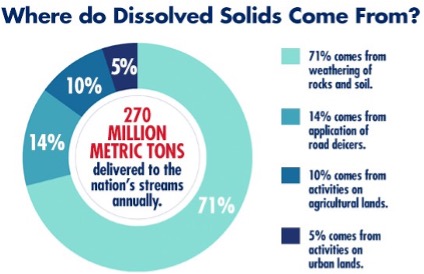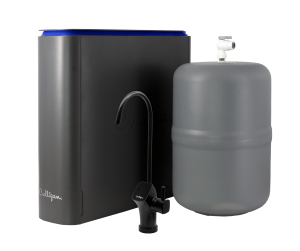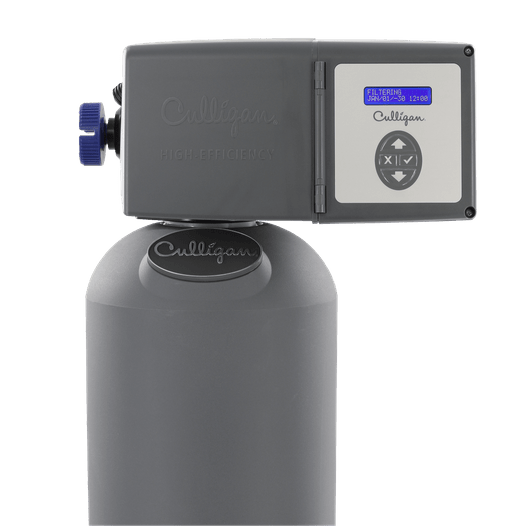How Do Total Dissolved Solids (TDS) Get Into Your Water?
The term TDS (Total Dissolved Solids) is the cumulative combination of any cations (positively charged) and anions (negatively charged) in your water.
TDS (cations) combined with carbonates, such as calcium (CaCO3) or magnesium (MgCO3) are associated with hardness, scale formation and bitter taste. Cations combined with chloride, such as sodium (NaCl) or potassium (KCl) can result in salty or brackish taste and increase corrosivity.
Having a test for TDS can tell you the total amount but will not identify the nature of these ionic relationships. You can purchase a TDS tester from Culligan’s water testing kit or get a FREE water test from your local Culligan dealer. A TDS tester is typically only the size of your hand, and you can use it again and again as a valuable tool.

Total Dissolved Solids and Water As A Solvent
Water is classified as an excellent solvent — something that has the ability to dissolve other substances. Because of this, it is able to snag impurities easily. In fact, the purest water, which is tasteless, odorless, and colorless, is the best solvent there is. It’s true that having a few dissolved solids – minerals and sodium in very small doses – are actually beneficial to your health.
Dissolved Solids and Water Quality
The EPA classifies TDS as a secondary drinking water standard, which means it is more of an aesthetic issue than a health risk, such as lead. But the concentration of any of these dissolved ions can damage your home, hair, and skin, and in rare cases, can be a detriment to your health.
A typical solution to this problem is a reverse osmosis filter if you are concerned with your drinking water. However, a whole house filtration solution is also available if you feel the need to take care of the entirety of your water system.

Typical Contaminants and Sources for TDS
TDS can come from a number of sources, and the location of your home, climate, water treatment method, source, and a number of variables can contribute to the composition of your water. Common TDS contaminants can include ionic compounds derived from calcium, magnesium, potassium, sodium, chlorides, sulfates, phosphates and nitrates.
Industrial Wastewater and Sewage – Treatment of both can include nitrates, which is important for animal growth. Algal blooms can be more likely to occur with the availability of nitrogen, causing an uptick in disinfectants being used by your municipality, which can lead to chlorine taste and smell. Phosphates can also be a non-point (water pollution from diffuse) source of TDS from wastewater treatment.
Urban Runoff – One of the leading sources in water quality problems, urban runoff occurs when rainwater runs across impervious surfaces through drainage systems. Some of these surfaces contain gasoline, motor oil, metals and trash, while lawns contain fertilizers and pesticides. Fertilizer is also a source of phosphorous and nitrates. Storm water runoff where de-icing salts are applied can also permeate drainage systems.
Piping/Hardware/Plumbing – The infrastructure of your own home could be the source of dissolved solids – particularly if the TDS is low. How can this be? Water in its purest form is a corrosive solvent and can rake toxic materials such as lead and copper into your household problem This can be a major health risk. It’s a rare event the water source in your home is so low in TDS that it could become an issue, but if you are concerned about this, have your water tested today.
Sea Water – Sea water, naturally, contains an excessive amount of NaCl (sodium) and other ionic compounds that can contribute to a salty or brackish taste. While there are a handful of desalination plants (designed to remove sodium compounds from sea water) in certain areas around the world, the hard truth is that purifying sea water takes an increased amount of time and energy to break such chemical bonds.
Agricultural/Farming/Irrigation Systems – Just like in lawn treatment, synthetic farm fertilizers have nitrates that can dissolve into the soil. Elevated levels of nitrates also occur in animal waste and compost. Nitrogen is an essential nutrient for plant growth. But excess nitrogen can combine with organic materials on the surface to product nitrates, which can be harmful to drinking water systems.
Naturally Occurring Total Dissolved Solids – When water makes its way through the ground, it encounters layers of limestone and chalk. These beds are typically comprised partly of calcium and magnesium bicarbonates. The bi-product of these dissolved solids is hard water. More than 85% of U.S. households have hard water, according to studies.
Solutions
Suggested Products

The Aquasential® Smart Reverse Osmosis Water Filter (RO)
- 7 stages of filtration and 12 filter options
- Certified for reduction of 58 contaminants
- 2-in-1 sediment and carbon filter screens out sediment and particles
- Can alert you and your dealer when service or filter replacements are needed

Aquasential™ Smart High Efficiency Whole House Water Filters
Reduce sediments in your water and contaminants that cause your water to appear, taste, and smell unpleasant. Your system can also lessen the taste and odor of chlorine, and prevent pipe damage and staining from low pH water. Additional customizations include:
- Culligan® Filtr-Cleer® Water Filters – Reduces Sediment Problems
- Culligan® Cullar® Water Filters – Reduces Taste and Odor Problems
- Culligan® Cullneu Water Filters – Reduces Acid Problems
